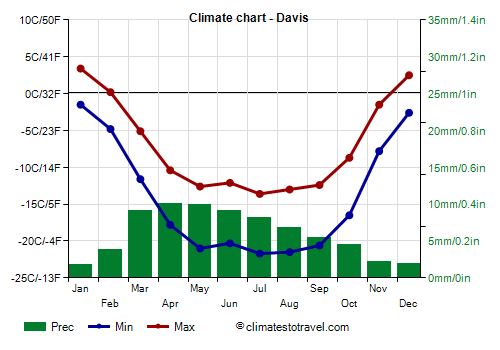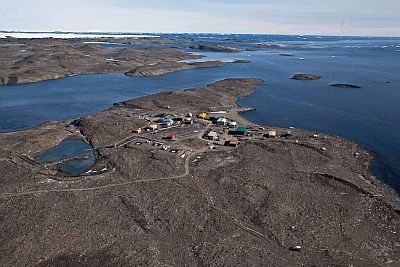Select units of measurement for the temperature and rainfall tables (metric or imperial).
Average weather, temperature, rainfall, sunshine hours

At the permanent Davis base, founded in 1957 and belonging to Australia, there is a
polar climate, with temperatures averaging below freezing almost all year round, except in summer, in December and January.
The station is located on the coast of Antarctica overlooking the Indian Ocean, in the portion called Ingrid Christensen Coast, at 68 degrees south latitude. We are in the so-called Princess Elizabeth Land.
About 105 kilometers (65 miles) to the southwest are two permanent bases close to each other, the Russian Progress 2 and the Chinese Zhongshan, while even further to the southwest is a deep ice-covered gulf, the Amery Ice Shelf. To the north-east of Davis, on the other hand, is the West Ice Shelf.
Davis has a
mild and dry microclimate. Despite the fact that it is the southernmost of the three permanent Australian bases, Davis is not the coldest, in fact, in winter it is slightly less cold than Mawson, while in summer it is a little milder than both Mawson and Casey. For this reason, Davis has been nicknamed, with some exaggeration, the "Riviera of the South."
Davis station is located in one of the so-called
Antarctic oases, and in particular, in the largest ice-free coastal area on the continent, with a surface area of 400 square km (154 sq mi), called
Vestfold Hills, made up of low hills, surrounded by hundreds of lakes and ponds of varying salinity. The southern part, called Marine Plain, is a protected area of paleontological and glaciological interest.
Local fauna includes species such as penguins, seals and elephant seals, as well as migratory birds.

The
wind is frequent, in fact it blows on average at 20 kph (12 mph), and at times it can be strong, however, Davis is also sheltered from the katabatic winds, which sweep the rest of the coast north of East Antarctica, because the wind in this area typically comes from the east, rather than rushing onto the coast directly from the plateau.
In winter, from May to September,
temperatures fluctuate greatly. In fact, sometimes the currents from the ocean prevail, and the temperature can approach freezing even in the coldest months, while in other periods, currents from inland areas can bring
periods of intense cold, up to -30 °C (-22 °F) or even below. The coldest record is -41.8 °C (-43.2 °F), set at the end of April 1998. In August 2023, the temperature dropped to -39.3 °C (-38.7 °F), and the average for the month has been -23.8 °C (-10.8 °F).
The sea on the coast freezes approximately from April to November.
In summer, temperatures are more stable, however, on milder periods, the temperature can reach or exceed 7/8 °C (45/46 °F). The heat record is 13 °C (55.5 °F), set in January 1974. After 2000, the record is 10.6 °C (51.1 °F), set in January 2002.
Here are the average temperatures.
Davis - Average temperatures (1991-2020) |
| Month | Min | Max | Mean |
|---|
| January | -1.5 | 3.4 | 1 |
|---|
| February | -4.8 | 0.2 | -2.3 |
|---|
| March | -11.6 | -5.1 | -8.4 |
|---|
| April | -17.8 | -10.4 | -14.1 |
|---|
| May | -21 | -12.6 | -16.8 |
|---|
| June | -20.3 | -12.1 | -16.2 |
|---|
| July | -21.7 | -13.6 | -17.6 |
|---|
| August | -21.5 | -13 | -17.2 |
|---|
| September | -20.6 | -12.4 | -16.5 |
|---|
| October | -16.5 | -8.7 | -12.6 |
|---|
| November | -7.8 | -1.5 | -4.6 |
|---|
| December | -2.6 | 2.5 | -0.1 |
|---|
| Year | -14 | -7 | -10.45 |
|---|
is decidedly low, just 75 millimeters (2.9 inches) per year, and this explains the absence of snow accumulated on the ground. In fact, if we exclude the coldest areas of the plateau, we are in one of the driest areas of Antarctica, with values comparable to the McMurdo dry valleys.
Precipitation almost all occurs in the form of
snow or sleet. However, sometimes, from November to February, it can also rain.
Here is the average precipitation.
Davis - Average precipitation| Month | Days |
|---|
| January | 2 | 2 |
|---|
| February | 4 | 3 |
|---|
| March | 9 | 6 |
|---|
| April | 10 | 6 |
|---|
| May | 10 | 6 |
|---|
| June | 9 | 5 |
|---|
| July | 8 | 5 |
|---|
| August | 7 | 5 |
|---|
| September | 5 | 5 |
|---|
| October | 4 | 4 |
|---|
| November | 2 | 2 |
|---|
| December | 2 | 2 |
|---|
| Year | 75 | 53 |
|---|
The amount of
sunshine at Davis station is not very good, given that it amounts to 1,500 hours per year. However, from November to January, thanks to the long days, the sun is visible for a good number of hours.
Here are the average sunshine hours per day.
Davis - Sunshine hours| Month | Average | Total |
|---|
| January | 9 | 285 |
|---|
| February | 6 | 170 |
|---|
| March | 3 | 100 |
|---|
| April | 2.5 | 70 |
|---|
| May | 0.5 | 20 |
|---|
| June | 0 | 0 |
|---|
| July | 0.5 | 10 |
|---|
| August | 2 | 60 |
|---|
| September | 4 | 125 |
|---|
| October | 5.5 | 170 |
|---|
| November | 8 | 235 |
|---|
| December | 10 | 305 |
|---|
| Year | 4.2 | 1545 |
|---|
Since it is located, albeit slightly, south of the polar circle, Davis station experiences the
polar night, from June 2nd to July 9th. However, around noon, for a few hours, the sun approaches the horizon, resulting in some twilight.
On the other hand, in summer the
polar day occurs, in which the sun never sets, from November 25th to January 18th. For a few weeks, before and after this period, the sun remains close to the horizon even at midnight, providing some light, so the so-called "white nights" occur.
On the summer solstice, December 21st or 22nd, at midday the sun reaches 45 degrees above the horizon, which is almost double that at the South Pole.